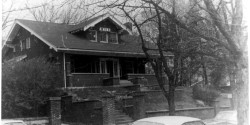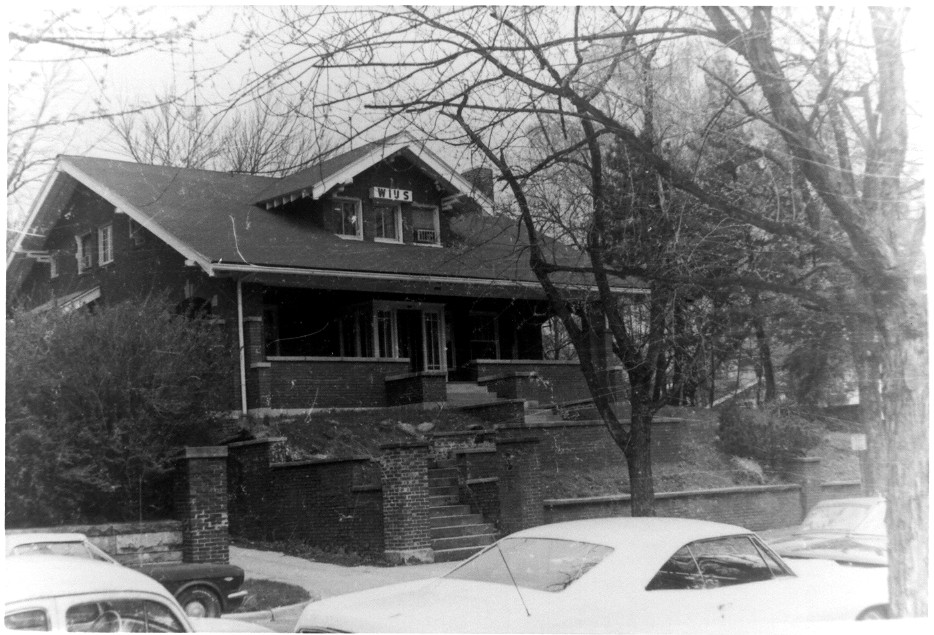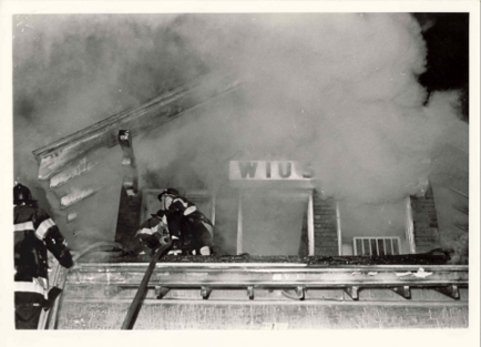We love to share stories about college radio history and in this guest post (part one of two), Greg Barman gives the back story on campus radio at Indiana University, which dates back to the launch of a carrier current station in 1962. Today, students run low power FM station WIUX-LP. Station alumni are gearing up for their 9th on-air reunion on July 24 and in preparation for that, here’s a closer look at the story behind WIUS, which was the moniker for a campus-wide network of stations beginning in 1967. – Editor
Later this month, a bunch of campus radio veterans from Indiana University will make an annual pilgrimage back to Bloomington, Indiana, where our campus radio station from the 1960s and ’70s will be waiting for us. When the night of Friday, July 24, arrives, the young DJ voices will give way to voices from their parents’ generation, as we put on our headphones again, cue up the jingles and good time rock ‘n’ roll records, and Pow! – the WIUS Alumni Weekend hits the air on WIUX-LP 99.1 FM, for the ninth year in a row!
How did this come about? For that, you have to know the long history – and all the drama — of IU campus radio. We’ve had our unique twists and turns.
The Beginnings
Campus radio at IU-Bloomington began life in January 1962 as carrier-current AM station WQAD in the Wright Quadrangle dormitory. A second station, WFQR (later WIN) soon emerged in dorms WQAD did not serve. A first step toward unification came with an IU Radio Network in 1966-67. In 1967, the stations merged into a campus-wide system believed to be one of the largest in the world at that time, serving 14,000 students. The new WIUS took the name “The Big 620,” played Top 40 rock and the beginnings of album rock, and sold advertising to Bloomington businesses to become a commercial and mostly self-sufficient independent campus entity. The station moved out of the dorms into a funky old two-story brick and wood house owned by the University, three blocks west of the IU campus. Ad sales were strong, listenership was high and things were looking good. Or, so we thought.
The Fire
On October 10, 1972, just before 5 a.m. when the station was off the air, a fire broke out at the station (listen to coverage of the fire). The flames woke up members of the fraternity next door, who called the Bloomington Fire Department. It quickly became a roaring blaze. As firefighters worked hard, it began getting statewide “pre-dawn blaze” news coverage. By 7 a.m. many of us had gathered on the street, watching our beloved radio station go up in flames, while we stood hugging each other and crying as if we had lost our own home. In a way, we did. Air studio and production equipment, the AP teletype and much of the record library burned, most of it a total loss. Fortunately, no one was injured. Within hours, investigators determined a cause. It was arson! Someone with sinister intentions that early morning had set three fires using a flammable liquid, one of them caught and it engulfed the house.
So who did it? No one was ever arrested or charged. Those of us who were there have theories as to which sick bastard could have done this. Some say a former station manager, others a former station member who had been kicked out or possibly any one of a number of people who weren’t happy with us. To this day, some of us hope that maybe, just maybe, the person responsible will confess in order to clear his conscience. But after 43 years, the chances appear dim.
The IU Radio-Television Department, which usually ignored WIUS, was actually quite generous and offered us the use of a studio for a week so we could get back on the air and begin the search for a new home. After that, we shoehorned what was left of the station’s equipment and record library into two small basement rooms in Wright Quad that had been WQAD’s second home in the mid ’60s. Talk about déjà vu.
Our New Home
WIUS stayed on the air in Wright Quad with marginal equipment and in space so tight that newscasts were assembled on the dorm unit’s ping-pong table. The new AP teletype was in a closet down the hall. In March 1973, WIUS moved into another IU-owned house – a classic four-bedroom, two-story brick home half a block from campus. The University said it would be “temporary.”
Throughout the ’60s and into the late ’70s WIUS benefited from a tremendous surge of creative student passion, vision and energy, resulting in a lively format of music and campus news. We had a solid core of radio junkies who spent so much time at the station that they joked that their real major was campus radio. We reached out to the “real world” and invited DJs and program directors from Indianapolis and Louisville Top 40 stations, who came to see what we were doing. WIUS’ signal became available in greater Bloomington for the first time through the local cable television system. The independence of having our own station house, for the most part away from the prying eyes of University administrators, gave us the freedom to create, learn, party and form relationships that would last for years. But student tastes, and media, had begun to change.
The ’80s doldrums
All student-run radio stations have theirs ups and downs. WIUS began a steep decline as the ’80s dawned. The passion and vision were gone. Many of the carrier-current AM transmitters deteriorated or failed. Bills went unpaid. Student interest in campus radio dwindled. Broadcasts became sporadic, and funding was so poor that portions of the WIUS house were rented out as student apartments. Alumni from the ’60s/’70s glory years who visited the place were heartbroken at what they saw. Some university funding eventually helped the situation, and when the IU dorms were wired for cable, WIUS became exclusively cable-accessible.
The Alternative ’90s
The ’90s saw a resurgence of student interest in WIUS. An alumnus from the 1970s, Bill Baker, and his Information Station Specialists helped WIUS become an over-the-air station for the first time in 1994 on 1570 AM, using a low-power transmitter identical to ones used for roadside traffic reports. AM radio had begun to die elsewhere, but “The Alternative AM 1570” became recognized in local “best of” polls and actively contributed to the local music scene. WIUS joined the high-tech movement in 1998 by adding a Real Audio server to its website, becoming one of the first campus stations to do so.
WIUS goes LPFM
Moving to FM had been a dream of WIUS managers and staff since the 1960s. In 2000, WIUS tried to make the leap when the FCC opened the first round of low power FM (LPFM) applications. Station managers applied for a license and hoped. As it turned out, WIUS was one of three applicants from Bloomington. At the time, the FCC lacked a quick process to resolve competing LPFM applications, so excitement and anticipation became disappointment, as the wait stretched on.
Meanwhile, WIUS alumni from the 1960s and ’70s stayed in touch with each other, and became friends and unofficial advisors to the students who ran the station. In 2004, a ’60s alum saw enough interest in a reunion, and he organized a summer weekend event attended by 150 people, including the station’s founders. Capping off the weekend was a celebratory dinner at IU’s Mather Museum, a world culture museum that, just coincidentally, was built on the exact site of the station house that burned in 1972!
The LPFM application was all but forgotten as weeks and months stretched into years. But one day in March 2005, the WIUS student station manager opened the station’s mail and discovered a construction permit from the FCC to build an LPFM station at 100.3 FM. Five years is a long time in the high-turnover world of student radio, and no one at the station was aware of the application filed in 2000. After checking around it finally dawned on them what they held in their hands.
WIUS alumni again stepped in to assist the station by helping to raise the money to purchase the transmitter and antenna and assist with construction. Because the WIUS call letters had long ago been taken by a student-run FM station in Macomb, Illinois, the station had to choose new calls. They picked something similar, but slightly edgier –WIUX! When WIUX-LP hit the air at 100.3 FM in January 2006, its indie-rock format was well-received by the local audience. More awards rolled in. Everything was going great! Or, so we thought.
Trouble Up and Down the Dial
WIUX had settled into its FM groove for only nine months when trouble hit, and it was so daunting that it threatened to knock the station off the air permanently. In October 2006, WIUS alumnus Bruce Quinn, a radio station owner, discovered that 100.3 was being assigned to Columbus, Indiana, 35 miles east of Bloomington, as part of a complex multi-state frequency shakeup intended to add new FM stations in the Louisville and Nashville markets. “Korn Country” WYGB was being moved to 100.3 as part of the big scheme, a change that was being made after the public comment period had closed and without the mandatory FCC notices. Because LPFM is a secondary service, full-power WYGB would blow WIUX off the air. The official FCC database showed no other available FM channels in Bloomington. Who would rescue WIUX this time?
Thanks to Quinn’s expert knowledge of frequencies in southern Indiana, he thought there was a possible “hole” in Bloomington at 99.1 that was not reflected in the official database. Indeed, there was, although just barely! So began a flurry of filings with the FCC in November 2006, beginning with a Petition for Reconsideration of the frequency moves. IU’s Dean of Students and Vice President of Student Affairs, Richard McKaig, filed an objection that noted that the University “did not have a fair chance to file public comments.” Both Indiana U.S. senators, Democrat Evan Bayh and Republican Richard Lugar, wrote letters of support for WIUX to the FCC. All of this succeeded nicely in stopping the frequency shuffle in its tracks and buying the station time.
In March 2007 a deal was struck for WIUX to move to 99.1, with “legitimate and prudent” expenses for the move to be paid by the radio chain that started the whole mess. On June 4, WIUX moved to its new home on the FM dial and the audience moved with it.
And so, again, WIUX was saved. The incident serves as a reminder to other LPFM stations of what could happen if they don’t stay informed about frequency changes in their area.
(Next week, in part two, we will focus on the station reunions and on the future of WIUX-LP)
Greg Barman is currently a Technical Recruiter in Denver, Colorado. Post-WIUS, he’s had 25+ years experience as a DJ, news reporter/anchor/News Director and talk show producer in commercial and non-commercial radio. He is a volunteer Board of Directors member for KOMF, a new community LPFM radio station under construction in Denver.





